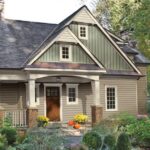House Painting This Fall | Let’s Get the House Ready!
Great Tips For Autumn House Painting

Fall is one of the best times of year to paint the exterior of your home, as most of us will try to avoid house painting during the balmy summer months and the winter is far too cold for such a task. By adding a fresh coat to your home’s exterior this fall, you can transform your residence and have it looking like new.
Now that the kids are getting ready to go back to school and you have all of this extra time on your hands, you’ll want to put it to good use. Let’s take a closer look at the following tips, so that you can make your South Jersey autumn house painting project a success.
Wait For The Temperatures To Drop
For the best possible results, it is best to wait for the temperatures to fall below 50 degrees Fahrenheit. When you attempt to paint during the summer or winter, the extreme temperatures can make for a far more difficult process. This is why smart homeowners will wait for autumn before taking on a project of this magnitude.
By waiting for the summer to pass and starting the project before the frigid temperatures of winter have arrived, homeowners are also providing themselves with an added level of comfort. House painting in South Jersey is essentially impossible during the winter, for any number of reasons and while the summer provides longer days and more light to work with, the prospect of house painting in the blazing sun is typically not palatable to most homeowners.
Choose The Best Time of Day
The best hours for house painting tend to fall between 10 AM and 3 PM. This allows homeowners to work during the time of day when they are provided with the most light and the temperatures are warm enough to work without disturbance. Working during the time of day when the sun is highest in the sky guarantees an even coat and those who follow this general rule of thumb are able to get the most out of their house painting project.
Waiting until nightfall only makes the job more difficult, as the homeowner is forced to set up adequate lighting so that they can complete the task. Early morning sunlight often creates an unbearable glare that makes the job much more difficult. By starting your house painting at 10 AM and completing your daily duties before 3 PM, you can avoid all of these common issues and complete the project more rapidly.
Follow The Sun
Once you’ve established the proper season, temperature and time of day, your best course of action is to start the house painting job on the sunny side of the home. When you paint the home during the summer, it is easier to begin on the shady side of the residence and work your way into the sun, but this method is not as effective. By starting on the sunny side of the home during the fall and painting into the shade, you are able to maximize the amount of daylight that you have at your disposal and finish the task more efficiently.
When you start on the shadier part of the home, the application of the paint often suffers as a result and the homeowner is often forced to go back and fix it. Those who elect the use the aforementioned method for painting their home get the job done right the first time and avoid the hassle of touching up the areas that they missed because they chose to adhere to the same technique that is used during the summertime.
Take Ample Time Between Coats
While painting during the fall provides a number of advantages from a weather standpoint, lower temperatures also mean that the new coats of paint will take a much longer time to dry. As a result of these much longer drying and curing times, you’ll need to allow for an ample amount of time in between each coat, so that your home is able to look its absolute best.
Should you decide to paint your home at temperatures of 50 degrees Fahrenheit or lower, it is important to wait at least 24 hours in between each coat. This allows the homeowner to avoid any unnecessary snafus and gives each coat a chance to fully dry before the second one is added. It may seem smarter to try and squeeze in two coats on the same day, but this will only cause additional problems over the long haul.
Check For The Dew Points
For those who are blissfully unaware of dew points and the role they play in your fall house painting project, here’s a helpful primer (no pun intended). The dew point is the point at which the outside moisture will condense on your painting surface. When you are applying paints, primers and stains, check the surface temperature of the area to make sure that it is at least 5 degrees (in Fahrenheit of course) higher than the dew point.
In addition, make sure that every surface that you are painting, priming or staining is completely clean and dry. If dew is able to form on a surface that was not given a chance to cure properly, you may experience spotting related problems in the future. This can be especially problematic for homeowners who have decided to use a darker color shade for their house painting project.
By following these useful tips, you can have your autumn house painting job done in no time at all and the aforementioned house painting pointers will also guarantee that the job is done right.










